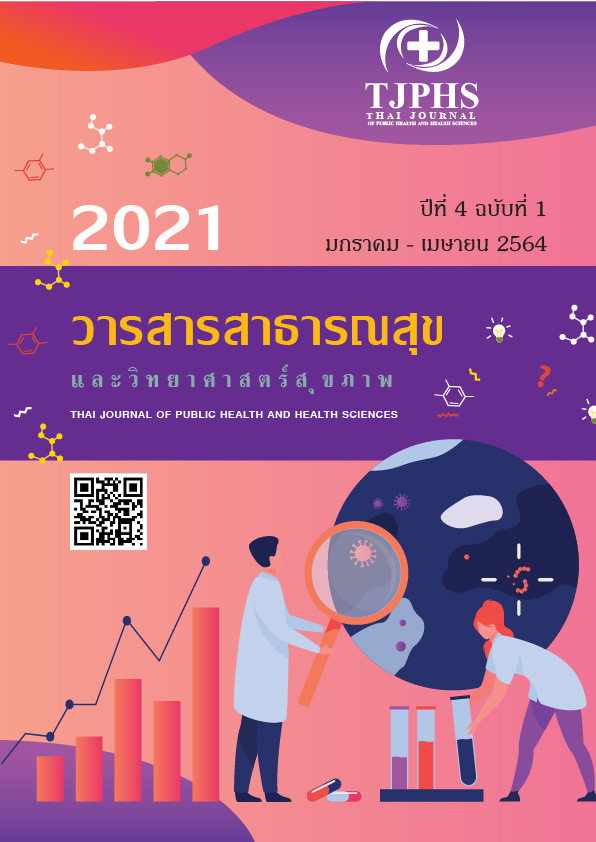ขอบเขตเชิงเนื้อหาในการประเมินผลกระทบทางสุขภาพ ของนโยบายเขตเศรษฐกิจพิเศษสงขลา
คำสำคัญ:
การประเมินผลกระทบทางสุขภาพ การกำหนดขอบเขต เขตเศรษฐกิจพิเศษบทคัดย่อ
การวิจัยครั้งนี้ มีวัตถุประสงค์เพื่อศึกษาการกำหนดขอบเขตเชิงเนื้อหาในการประเมินผลกระทบทางสุขภาพของนโยบายเศรษฐกิจพิเศษสงขลา วิธีการกำหนดขอบเขตเชิงเทคนิคโดยการวิจัยเอกสารอย่างเป็นระบบและนำมาสรุปเป็นร่างขอบเขตเชิงเนื้อหาโดยผู้เชี่ยวชาญ และการกำหนดขอบเขตโดยชุมชน โดยการจัดประชุมกลุ่มย่อย กลุ่มผู้ให้ข้อมูล ประกอบด้วย ตัวแทนประชาชนในพื้นที่ ตัวแทนภาครัฐ เอกชน ตัวแทนองค์กร กลุ่มจัดตั้งอื่นๆ และประชาชนผู้สนใจจำนวน 20 คน เครื่องมือในการวิจัย คือตารางการสกัดข้อมูล แนวคำถามการประชุมกลุ่มย่อย เก็บรวบรวมข้อมูลโดยการสนทนากลุ่ม วิเคราะห์ข้อมูลโดยวิธีวิเคราะห์เชิงเนื้อหาและการยืนยันโดยผู้เชี่ยวชาญ
ผลการศึกษาพบว่า ขอบเขตเชิงเนื้อหาที่ต้องศึกษา มี 4 ด้าน คือ 1) ด้านเศรษฐกิจ ประกอบด้วย รายได้ การจ้างงาน การว่างงาน การเปลี่ยนแปลงอาชีพ การถือครองที่ดินและการใช้ประโยชน์ที่ดิน 2) ด้านสังคม ประกอบด้วย การเคลื่อนย้ายประชากร วิถีชีวิต แรงงาน อาชญากรรม ยาเสพติด การพนัน ประเพณี วัฒนธรรม และปัญหาครอบครัว 3) ด้านสิ่งแวดล้อม ประกอบด้วย มลพิษทางอากาศและฝุ่นละออง เสียง กลิ่น การสั่นสะเทือน การจัดการขยะ การเปลี่ยนแปลงระบบนิเวศและป่าไม้ คุณภาพน้ำ ระบบสาธารณูปโภค การคมนาคมขนส่ง 4) สุขภาพและระบบบริการสาธารณสุข ประกอบด้วยการเจ็บป่วยด้วยโรคต่างๆ เช่น โรคติดต่อทางเพศสัมพันธ์ โรคไม่ติดต่อ โรคอุบัติใหม่ โรคทางจิตเวช โรคจากการประกอบอาชีพและสิ่งแวดล้อม การจัดการระบบสาธารณสุข และอุบัติเหตุ ขอบเขตเชิงเนื้อหาทั้ง 4 ด้านหลักจะถูกนำไปใช้เป็นกรอบแนวทางสำหรับการพัฒนาตัวชี้วัดและเครื่องมือในการประเมินผลกระทบทางสุขภาพของนโยบายเขตเศรษฐกิจพิเศษต่อไป
เอกสารอ้างอิง
The Republic of the Union of Myanmar (Translation of Japanese version) (Investigation Report). Japan: Japan International Cooperation Agency
Aradhna, A. (2007) Impact of Special Economic Zones on Employment, Poverty and Human Development (Research report.) New Delhi: Indian Council for Research on
International Economic Relations.
Banhalmi-Zakar, Z., Gronow, C., Wilkinson, L., Jenkins, B.,Pope, J., Squires, G., Witt, K.,
Williams, G., & Womersley,J. (2018). Evolution or revolution: Where next for
impactassessment? Impact Assessment and Project Appraisal,36(6), 506–515.
Chalermwut, U. (2017). Strategic Environmental Assessment: Alternatives for Area
Development of the Special Economic Zone Chiang Khong District, Chiang Rai Province (Master’s thesis). National Institute of Development Administration, Bangkok. (In Thai)
Consultants of Technology Co., Ltd. (2014). The meeting summary of open-mindedness to
scoping and guidelines for environmental and health impact assessment of Thermal power plant 600 MW project, Chachoengsao. Retrieved Sep 10, 2016, from http://www.thia.in.th/uploads/file/EHIA%202014/NPS%20Khohinsorn%20600%20MG/201409_NPS_Khohinsorn_PS_letter+info.pdf
Department of Strategy and Area development planning. (2014). Study on Management of
Special Economic Zone Development in Iskandar, Malaysia and City planning in Singapore (Report). Bangkok: Office of the National Economic and Social Development Council. (In Thai)
Duangratchanee, K., & Chamlong, P. (2015). Strategic Environmental Assessment (SEA) of
Special Economic Zone (SEZ) Development Strategy, Chiang Saen District, Chiang Rai Province. Journal of Community Development Research (Humanities and Social Sciences), 8(3), 125-138 (In Thai)
Frantisek, L., Slavka, K., & Viliam K. (2015). Special Economic Zone Constitution According to
Cluster Analysis. Procedia Economics and Finance, 27, 186-193
Jiranon, P, & Chamlong, P. (2015). Strategic environmental assessment (SEA) of Kanchanaburi
special economic zone (SEZ) development strategy. Journal of Thai Interdisciplinary Research, 10(2), 8-15 (In Thai)
Kornkaran, C., Jittichai, R., Panutat, S., Sottithon, M., Pattanaporn, K., Aek, T. (2014).
Guidelines and measures of special economic zone development in Thai border areas (Research report). Bangkok: International Institute for Trade and Development. (In Thai)
Kornkaran, C., Jittichai, R., Panutat, S., Sottithon, M., Pattanaporn, K., Aek, T., … Chanikarn, W.
(2014). Guidelines and measures of special economic zone development in Thai border areas (Research report). Bangkok: International Institute for Trade and Development. (In Thai)
Local Act. (2016). Potential and local knowledge to prevent social and environmental
impacts of Special Economic development in Mukdahan, Thailand (Research report). Nonthaburi: Foundation of Reclaiming Rural Agriculture and Food Sovereignty Action. (In Thai)
Mathurada, S. (2015). Border Trade and Economic Development: Case Study of “Friendship
Border Market Thai-Cambodia” Sakaeo Province. Academic Services Journal Prince of Songkla University, 25(1), 22-30 (In Thai)
Pavarisorn, L., Wannivapa, P., & Wipavee, R. (2017). The development of Special Economic
Zones follows by ASEAN Guidelines for Special Economic Zones (SEZs) (Research report). Bangkok: The secretariat of the senate. (In Thai)
Pittaya, S., Kanokwan U., Sivarin, L., & Tatchakorn, B. (2016). The Impacts of Maesot (Thailand)-Myawaddy Special Economic Zone (Myanmar) Under ASEAN Economic Community. Political Science and Public Administration Journal, 7(2), 30-44 (In Thai)
Thanawut, T. (2017). Padang Besar Special Economic Zone: Effect, Obstacles and
Development (Master’s thesis). Prince of Songkla University, Songkhla. (In Thai)
Thomas, F. (2011). Special Economic Zones in Africa. Comparing Performance and Learning
from Global Experiences (1st ed.). 1818 H Street NW Washington DC: The World Bank
Vidya, B. R., Mamidi, B. R., & Sujatha, S. (2011). The impact of Special Economic Zones in India: A case study of Polepally SEZ. In M. Niasse (Ed.), Commercial Pressures on Land (24-36). Rome, Italy: International Land Coalition Secretariat
ดาวน์โหลด
เผยแพร่แล้ว
รูปแบบการอ้างอิง
ฉบับ
ประเภทบทความ
สัญญาอนุญาต
บทความทุกบทความที่ได้รับการตีพิมพ์ถือเป็นลิขสิทธิ์ของ วารสารสาธารณสุข
















